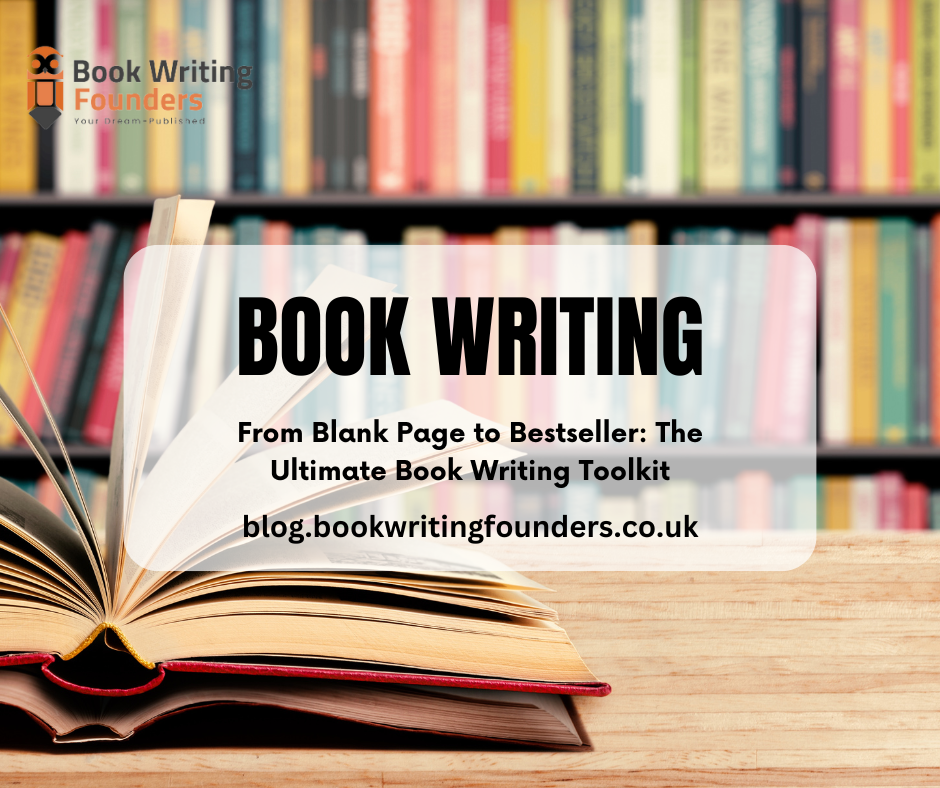
Writing
Ever wondered what sets a bestseller apart from the rest? It’s not just luck or chance. A bestseller is a product of careful planning, skilful execution, and a deep audience understanding.
In book writing, proper planning is the secret weapon of successful authors. Planning your writing journey can make all the difference before you even put pen to paper or fingers to keyboard.
From outlining your plot and fleshing out your characters to scheduling dedicated writing sessions and setting realistic deadlines, careful planning benefits every aspect of the writing process.
A Comprehensive Roadmap for Writing Your Bestseller
Book Writing Founders UK breaks down these components and shows how they combine to make a book a bestseller. Knowing these elements is essential for anyone serious about writing a book that connects with readers and lasts.
1- Understanding Your Why: Defining Your Purpose
Take some time to prepare your mindset. This means getting yourself mentally ready for the journey ahead. Consider what motivates you to write and envision the end goal you’re aiming for.
To stay motivated and focused throughout your book writing journey, it’s essential to understand the “why” behind your decision to write a book. Take some time to reflect on what inspired you to embark on this journey in the first place. Is it a story you’re passionate about sharing?
A desire to educate or entertain others? Or perhaps a personal goal you’ve always wanted to achieve? Defining your purpose gives you a clear sense of direction and motivation to keep moving forward, even when faced with challenges or setbacks.
Reflect on your strengths and acknowledge any potential challenges you may face. By setting a positive and determined mindset, you’ll be better equipped to tackle the writing process with confidence and resilience.
2- The Blueprint: Creating Your Book Structure
Crafting a solid book structure is like architecting the framework upon which your entire story will be built. It serves as the blueprint that guides you through the intricate maze of plotlines, character developments, and thematic arcs, ensuring that every element of your narrative falls seamlessly into place.
Much like constructing a building, a well-thought-out structure provides stability, coherence, and direction to your storytelling journey, allowing readers to navigate your narrative easily and engage.
3- The Importance of Outlining
Outlining is the cornerstone of effective book writing, serving as the scaffolding upon which your literary masterpiece will take shape. By meticulously plotting the story, you lay the groundwork for a cohesive and compelling narrative that resonates with readers.
An outline acts as a roadmap, guiding you through the twists and turns of your plot. Also provides a clear framework for character development, thematic exploration, and pacing. Whether you’re a free-spirited painter, outlining cannot be overstated in ensuring that your story unfolds purposefully and precisely.
4- Exploring Different Structural Approaches (Linear vs. Non-linear)
When it comes to structuring your book, there are various paths you can take. Therefore, each offers its own unique set of challenges and opportunities. A linear structure follows a chronological sequence of events, providing readers a straightforward journey from beginning to end.
This approach is ideal for narratives that rely on a clear cause-and-effect progression. It allows readers to easily follow the flow of the story.
On the other hand, a non-linear structure offers a more unconventional approach, playing with time, perspective, and narrative order to create a sense of intrigue and mystery.
Find out the nuances of both linear and non-linear storytelling. You can experiment with different structural approaches to find the one that best serves your story and enhances its impact on readers.
5- Utilizing Plot Devices and Story Arcs
Plot devices and story arcs are the building blocks of book writing, imbuing your narrative with tension, conflict, and emotional resonance. From dramatic twists and turns to satisfying character arcs, these elements add depth and dimension to your story, keeping readers invested from the opening pages to the final chapter.
By strategically incorporating plot devices such as foreshadowing, symbolism, and dramatic irony, you can create moments of suspense and surprise that leave a lasting impression on readers.
Similarly, by crafting well-defined story arcs for your characters, you can chart their growth, transformation, and ultimate redemption throughout the narrative. By harnessing the power of plot devices and story arcs, you can elevate your storytelling to new heights.
Therefore, creating a compelling and immersive reading experience lingers long after turning the final page.
6- Developing Unforgettable Characters
Creating memorable characters is the heart and soul of storytelling, breathing life into your narrative and forging connections with your readers that transcend the pages of your book.
Through thoughtful exploration, you have the power to bring characters to life in a way that resonates deeply with your audience. Also leaving a lasting impression long after the story has ended.
Character development sculpts individuals who feel authentic, relatable, and compelling, regardless of their role in the story.
From the noble protagonist driven by ambition and courage to the cunning antagonist fueled by ambition and desire, every character serves a vital purpose in driving the narrative forward.
7- Writing Techniques and Tips
Mastering the art of book writing requires more than just a flair for words; it demands a combination of skill, creativity, and dedication. Whether you’re a seasoned author or a budding writer, honing your craft involves continuously refining your techniques and embracing new approaches to storytelling.
8- Harnessing the Power of Voice and Tone
Voice and tone are essential elements that shape the personality and mood of your writing. Voice refers to the unique style and perspective that makes your writing different. Therefore, tone reflects the attitude or emotion conveyed through your words.
To harness the power of voice and tone, consider the intended audience and purpose of your writing. Experiment with different styles. Use impactful language use from formal and authoritative to casual and conversational. Therefore, you will find the voice and tone that best suits your message and resonates with your readers.
9- Utilizing Descriptive Language and Imagery
Descriptive language and imagery are powerful tools for engaging readers and immersing them in your story world. You can bring your writing to life and evoke emotions in your readers. Use writing tools to describe characters and events, appealing to the five senses to create a sensory-rich experience.
Experiment with metaphor, simile, and other literary devices to add depth. Also, it adds complexity to your writing, transporting readers to new worlds and inviting them to see, hear, smell, taste, and feel alongside your characters.
10- Balancing Dialogue and Narrative
Dialogue and narrative are two essential components of storytelling, each serving a distinct purpose in advancing the plot and developing characters. Dialogue allows characters to interact with one another, revealing their personalities, relationships, and conflicts through conversation.
Narrative, on the other hand, provides context, description, and exposition. It guides readers through the story and shapes their understanding of the characters and events. Consider the pacing and rhythm of your writing, alternating between dialogue-heavy scenes and narrative passages to maintain momentum and hold readers’ interest.
11- Self-Editing Techniques for Clarity
Effective self-editing is crucial in polishing your manuscript and ensuring it is clear, cohesive, and engaging for readers. Start the editing process by stepping back from your work and approaching it with fresh eyes.
Read through your manuscript carefully, focusing on aspects such as sentence structure, grammar, and punctuation. Pay attention to transitions between paragraphs
and chapters to ensure a smooth flow of ideas throughout the narrative.
Additionally, watch out for repetitive language or unnecessary words that can clutter your prose and detract from your message.
12- Seeking Feedback from Beta Readers
Beta readers play a vital role in the editing and revision process by offering fresh perspectives and valuable insights into your work. Choose beta readers who represent your target audience.
Therefore, provide them a clear understanding of what you hope to achieve with your manuscript. Encourage them to provide honest and constructive feedback on various aspects of your writing, Take note of their observations and suggestions.
13- Working with Professional Editors
Professional editors are pivotal in shaping your manuscript into a polished, publishable work. Consider a professional editing service or hire an editor specializing in your genre or field of writing.
Be open to receiving constructive criticism and be prepared to collaborate closely with your editor to address any areas of concern. Remember that the goal of editing is not to change your voice or style but to enhance the clarity, coherence, and overall impact of your writing.
Conclusion
Ultimately, whether your book becomes a bestseller or not, the true reward lies in the book-writing journey—the moments of inspiration, the triumphs over adversity, and the connections forged with readers who resonate with your words.
So keep writing, keep dreaming, and keep pushing forward. Your story is waiting to be told, and the world eagerly awaits reading it.




